Clear filter
Article
Yuri Marx · Dec 21, 2020
Today, is important analyze the content into portals and websites to get informed, analyze the concorrents, analyze trends, the richness and scope of content of websites. To do this, you can alocate people to read thousand of pages and spend much money or use a crawler to extract website content and execute NLP on it. You will get all necessary insights to analyze and make precise decisions in a few minutes.
Gartner defines web crawler as: "A piece of software (also called a spider) designed to follow hyperlinks to their completion and to return to previously visited Internet addresses".
There are many web crawlers to extract all relevant website content. In this article I present to you Crawler4J. It is the most used software to extract website content and has MIT license. Crawler4J needs only the root URL, the depth (how many child sites will be visited) and total pages (if you want limit the pages extracted). By default only textual content will be extracted, but you config the engine to extract all website files!
I created a PEX Java service to allows you using an IRIS production to extract the textual content to any website. the content is stored into a local folder and the IRIS NLP reads these files and show to you all text analytics insights!
To see it in action follow these procedures:
1 - Go to https://openexchange.intersystems.com/package/website-analyzer and click Download button to see app github repository.
2 - Create a local folder in your machine and execute: https://github.com/yurimarx/website-analyzer.git.
3 - Go to the project directory: cd website-analyzer.
4 - Execute: docker-compose build (wait some minutes)
5 - Execute: docker-compose up -d
6 - Open your local InterSystems IRIS: http://localhost:52773/csp/sys/UtilHome.csp (user _SYSTEM and password SYS)
7 - Open the production and start it: http://localhost:52773/csp/irisapp/EnsPortal.ProductionConfig.zen?PRODUCTION=dc.WebsiteAnalyzer.WebsiteAnalyzerProduction
8 - Now, go to your browser to initiate a crawler: http://localhost:9980?Website=https://www.intersystems.com/ (to analyze intersystems site, any URL can be used)
9 - Wait between 40 and 60 seconds. A message you be returned (extracted with success). See above sample.
10 - Now go to Text Analytics to analyze the content extracted: http://localhost:52773/csp/IRISAPP/_iKnow.UI.KnowledgePortal.zen?$NAMESPACE=IRISAPP&domain=1
11 - Return to the production and see Depth and TotalPages parameters, increase the values if you want extract more content. Change Depth to analyze sub links and change TotalPages to analyze more pages.
12 - Enjoy! And if you liked, vote (https://openexchange.intersystems.com/contest/current) in my app: website-analyzer
I will write a part 2 with implementations details, but all source code is available in Github. Hi Yuri!Very interesting app!But as I am not a developer, could you please tell more about the results the analizer will give to a marketer or a website owner? Which insights could be extracted form the analysis? Hi @Elena.E
I published a new article about marketing and this app: https://community.intersystems.com/post/marketing-analysis-intersystems-website-using-website-analyzer
About the possible results allows you:
1. Get the most popular words, terms and sentences wrote into the website, so you discover the business focus, editorial line and marketing topics.
2. Sentiment analysis into the sentences, the content is has positive or negative focus
3. Rich cloud words to all the website. Rich because is a semantic analysis, with links between words and sentences
4. Dominance and frequence analysis, to analyze trends
5. Connections paths between sentences, to analyze depth and coverage about editorial topics
6. Search engine of topics covered, the website discuss a topic? How many times do this?
7. Product analysis, the app segment product names and link the all other analysis, so you can know if the website says about your product and Services and the frequency Hi Yuri!
This is a fantastic app!
And works!
But the way to set up the crawler is not that convenient and not very user-friendly.
You never know if the crawler works and if you placed the URL right.
Is it possible to add a page which will let you place the URL, start/stop crawler and display some progress if any?
Maybe I ask a lot :)
Anyway, this is a really great tool to perform IRIS NLP vs ANY site:
Announcement
Anastasia Dyubaylo · Dec 12, 2020
Hey Developers,
Please welcome the new video by @sween on InterSystems Developers YouTube:
⏯ InterSystems IRIS Native Python API in AWS Lambda
In this video, you will learn the seamless InterSystems IRIS functionality in the AWS Serverless ecosystem.
Leave your questions in the comments to this post.
Enjoy and stay tuned!
Announcement
Olga Zavrazhnova · Dec 14, 2020
Hi Developers,
We invite you to take a few minutes and leave a review about your experience with InterSystems IRIS on the TrustRadius. Submitting a review requires time and effort, so we'll be glad to reward you with a $25 VISA Gift Card for a published review! UPDATE: this promotion ended in 2021.
To get a $25 VISA card from InterSystems follow these steps:
✅ #1: Follow → this link ← to submit a review (click on the "Start My Review" button).
✅ #2: Your review will have a title (headline). Copy the text of the headline of your review and paste it in this challenge on Global Masters.
✅ #3: After your review is published you will get the $25 VISA Cards and 3000 points on Global Masters.
Please note:
TrustRadius must approve the survey to qualify for the gift card. TrustRadius will not approve reviews from resellers, systems integrators, or MSP/ISV’s of InterSystems.
TrustRadius does not approve the reviews that have been previously published online.
Done? Awesome! Your gift card is on the way!
Hmm. The link to GM says:
Ooops!
Sorry friend, looks like this challenge is no longer available.
My title: " Never say IMPOSSIBLE with IRIS "
Hi Robert, thank you for submitting a review for us! I made some corrections to the challenge, so the link should work for you now. THX. Just verified it. Hi, the GM link is broken. It says:
Ooops!
Sorry friend, looks like this challenge is no longer available. here it is:https://www.trustradius.com/reviews/intersystems-iris-2020-12-15-16-53-48 Hi Akshay,I see you registered recently - welcome to Global Masters! Could you please complete this challenge first? After it's done the TrustRadius challenge will be unlocked for you. Thank you, Robert! Your gift card is already opened for you on GM Thanks for your help. Here's the published review! https://www.trustradius.com/reviews/intersystems-iris-2020-12-23-14-00-04 Hi Akshay! So great, thank you! Your reward is opened for you on Global Masters. Happy New Year! There seems to be some error. I clicked on Redeem, and my card just disappeared. It is not showing in the Rewards section either! That's the way it works. You consume it once.You'll get a mail once processed. But probably not this year Ah no issues, I'll wait until next year. I've got nothing but time. Thanks though!! I can't see any challenges... What do I do now? Great Unable to paste in challenge on Global Master
Article
Mihoko Iijima · Mar 5, 2021
**This article is a continuation of this post.**
In the previous article, we discussed the development of business processes, which are part of the components required for system integration and serve as a production coordinator.
This article will discuss creating a business service, which is the information input window for production.
* Production
* Message
* **Components**
* **Business services**
* Business processes(previous post)
* Business operation
And finally, the last component of “Let's Use Interoperability!”
The business service provides a window of input for information sent from outside IRIS, with or without using the adapter for external I/F.
There are three types of business services in the sample (links in parentheses are links to the sample code):
1. [Business services for files using inbound adapters](#fileinboundadapter)(Start.FileBS)
2. [Business services for Web services using the SOAP inbound adapter](#soapinboundadapter)(Start.WS.WebServiceBS)
3. [Business service called by stored procedure or REST without using an adapter](#nonadapter)(Start.NonAdapterBS)
Different connection methods used for inputting information will only increase the number of business services; however, the processing done within a business service is
Create a request message to be sentusing externally inputted information and simply call the business component
It's effortless.
Now, let's outline how to create components that use file-inbound adapters.
Business services are written in scripts, which can be created in VSCode or Studio (see this article on using VSCode).
### 1. Business services for files using inbound adapters(Start.FileBS)
If you create a class in VSCode, you should create a class that inherits from Ens.BusinessService. As for adapters, you can use the **ADAPTER** parameter as ADAPTER class name (e.g., specify a file-inbound adapter class).
If you do not use the adapter, no configuration is required.
```objectscript
Class Start.FileBS Extends Ens.BusinessService
{
Parameter ADAPTER = "EnsLib.File.InboundAdapter";
```
In the file-inbound adapter, you can specify the directory to be monitored in Settings→File Path for the production's business service.
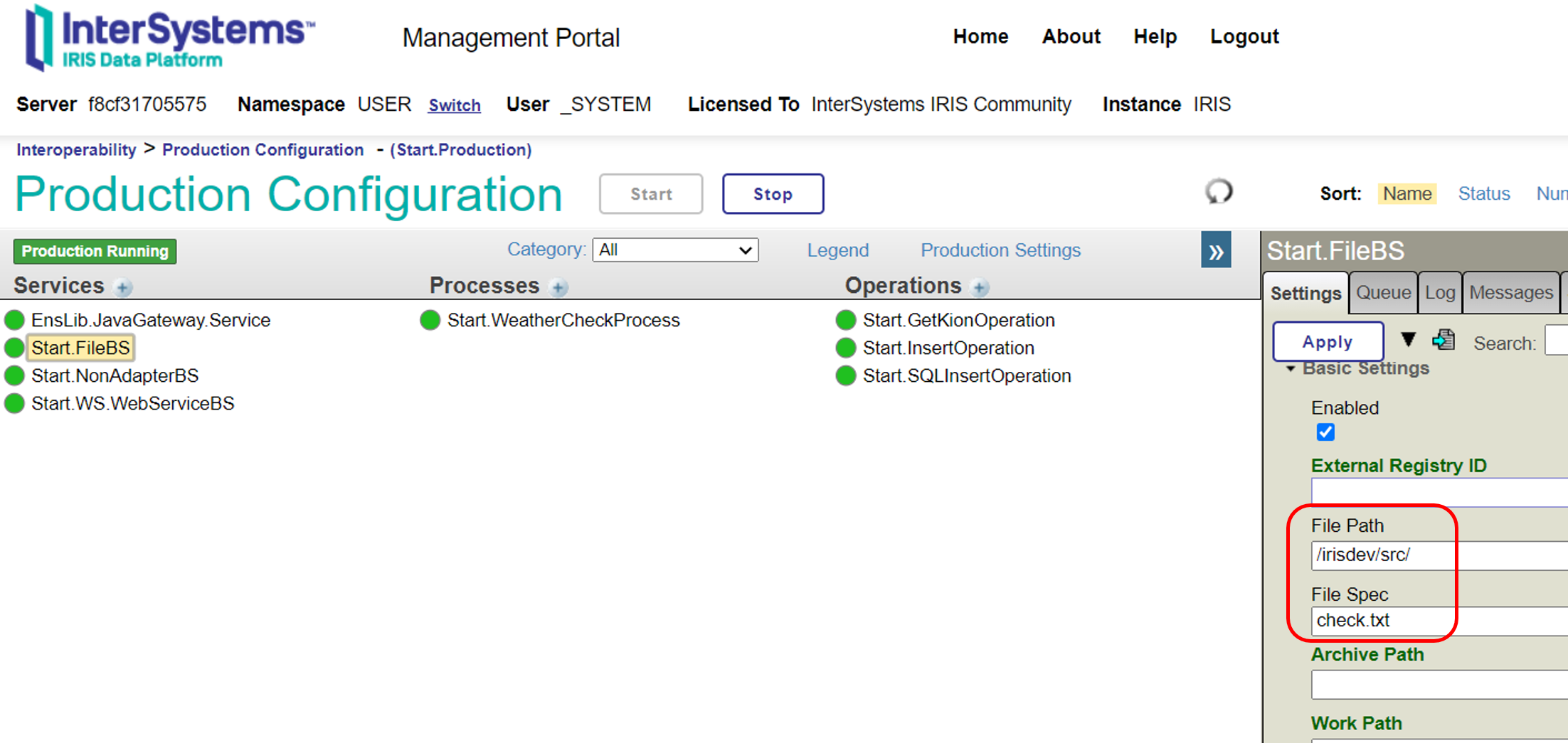
If the file located in the "File Path" matches the information specified in the "File Spec," it opens the file as a stream object. It defines it as the first variable when calling the business service **ProcessInput()**.
When **ProcessInput()** is started, **OnProcessInput()** is automatically called. OnProcessInput() is passed directly to **OnProcessInput()** with the parameters passed to ProcessInput().
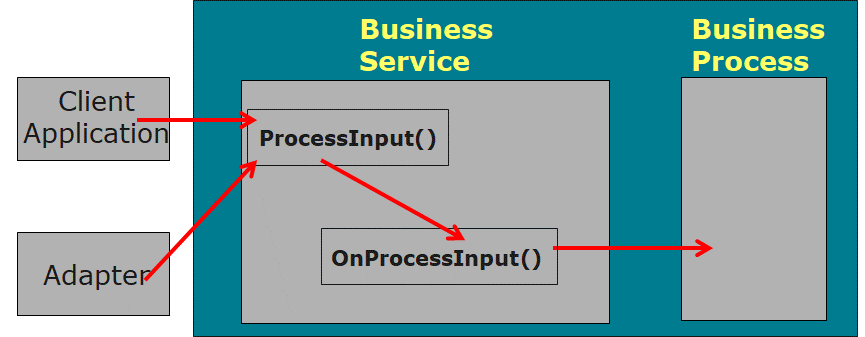
In **OnProcessInput()** the initial statement gets the information from the file stream object, which is passed as the first parameter, then creates a message to be given to the next component, writes the process of calling the next component, and completes the basic logic.
* * *
【Memo】For Studio, launch the Business Services Wizard in the New Creation menu, select the adapter and press the Finish button.
* * *
The **OnProcessInput()** method definition is as follows:
```objectscript
Method OnProcessInput(pInput As %Stream.Object, Output pOutput As %RegisteredObject) As %Status
```
**pInput** is provided with an instance of the **%Stream.FileCharacter** class for text files or the **%Stream.FileBinary** class for binary files.
In the sample, a file in text format will be inputted, and we have written it to accept multi-line requests and one request per line.
**AtEnd property** is set to 1 when EndOfFile is deteced. You can use this property to stop loop.
In a loop, we read the lines using the **ReadLine()** method, which enables us to obtain information about the contents of the file one line at a time (see the documentation for file adapter details).
Compose the message, retrieving information line by line. Then, we execute the ..SendRequestAsync() method, which calls the other components.
When executing the method, the first parameter should be the name of the component you want to call as a string, and the second parameter should be the request message you have created.
Note that the ..SendRequestAsync() is an asynchronous call and does not wait for a response.
Memo:There is also SendRequestSync() for synchronous calls.。
The sample code is as follows:
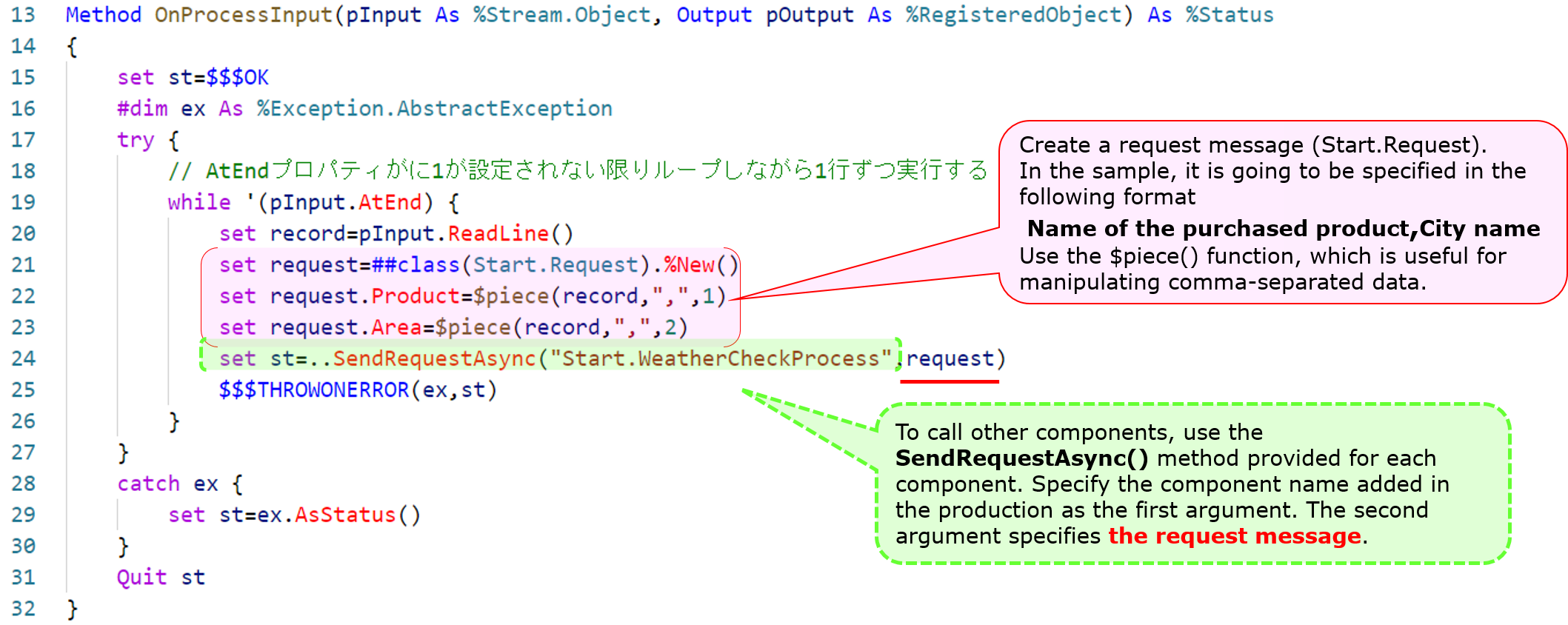
Reference:explanation of the usage of the $piece() function in the above example text
$piece(“string”, ”delimiter mark”, ”position number”)
The function to set/get a string with a delimiter, in the sample, to get the first and second value of comma-separated data, is written with the following syntax:
```objectscript
set request.Product=$piece(record,",",1)
set request.Area=$piece(record,",",2)
```
Now, let's check the function of Start.FileBS as it appeared in the above description.
In the sample production, the "File Path" was set to **/irisdev/src**, and the "File Spec" was set to **check.txt**. Either prepare the same directory or change it to a different directory and register the sample data in the check.txt file using the following format: purchased product name, name of the city.
※If you are using the sample container, please rename [Test-check.txt] in the src directory under the directory created by the git clone.
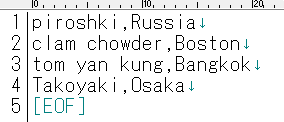
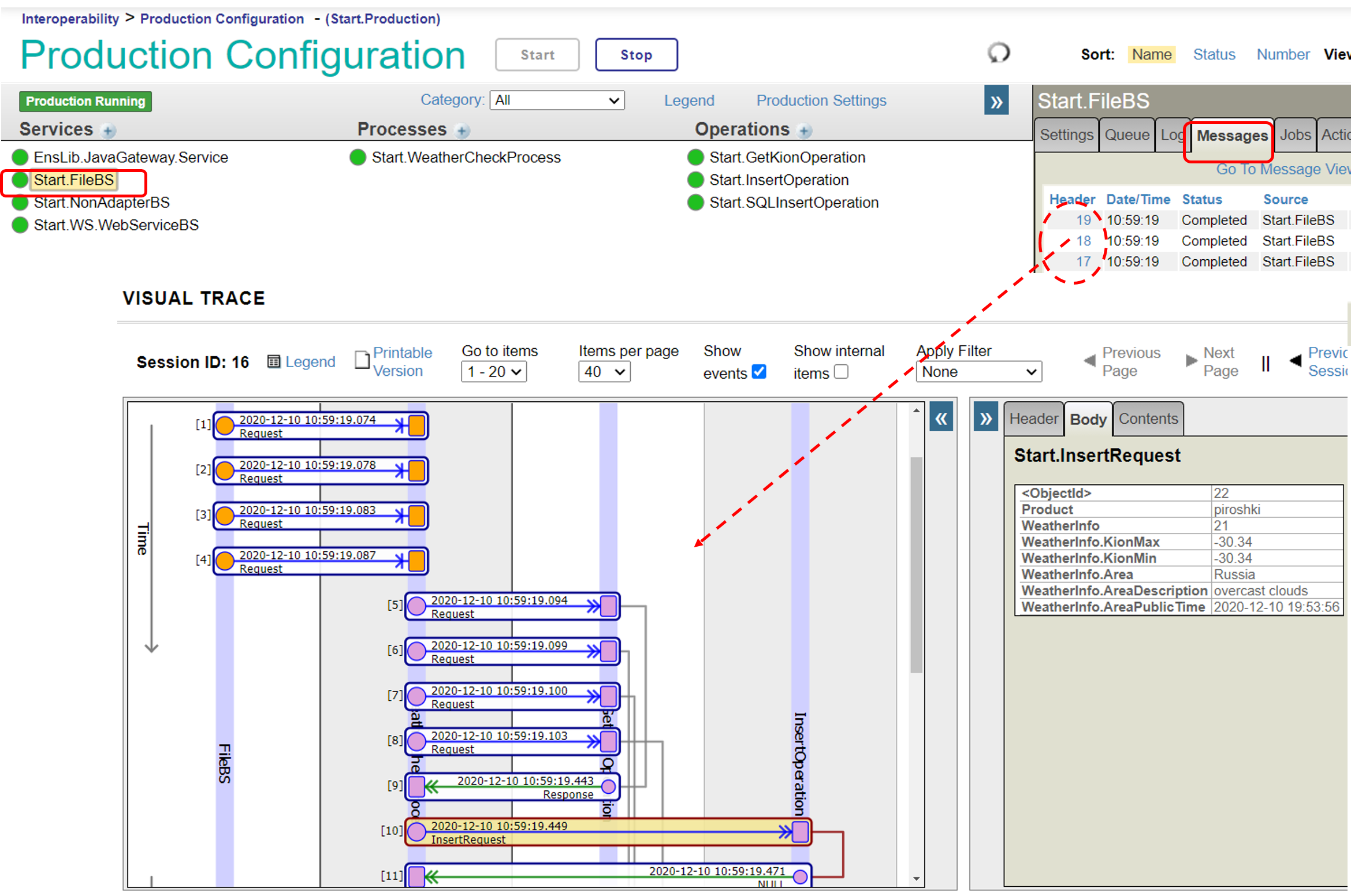
### 2. Business services for Web services using the SOAP inbound adapter (Start.WS.WebServiceBS)
Next, we will outline the creation of business services for Web services.
The Business Service Class for Web Services acts as a Web Service Provider = Web Service Server.
In the sample, we have two parameters in the Web service method for this sample production to have information sent from the Web service client. The web method uses the data entered in the parameters to create a message class and call other components.
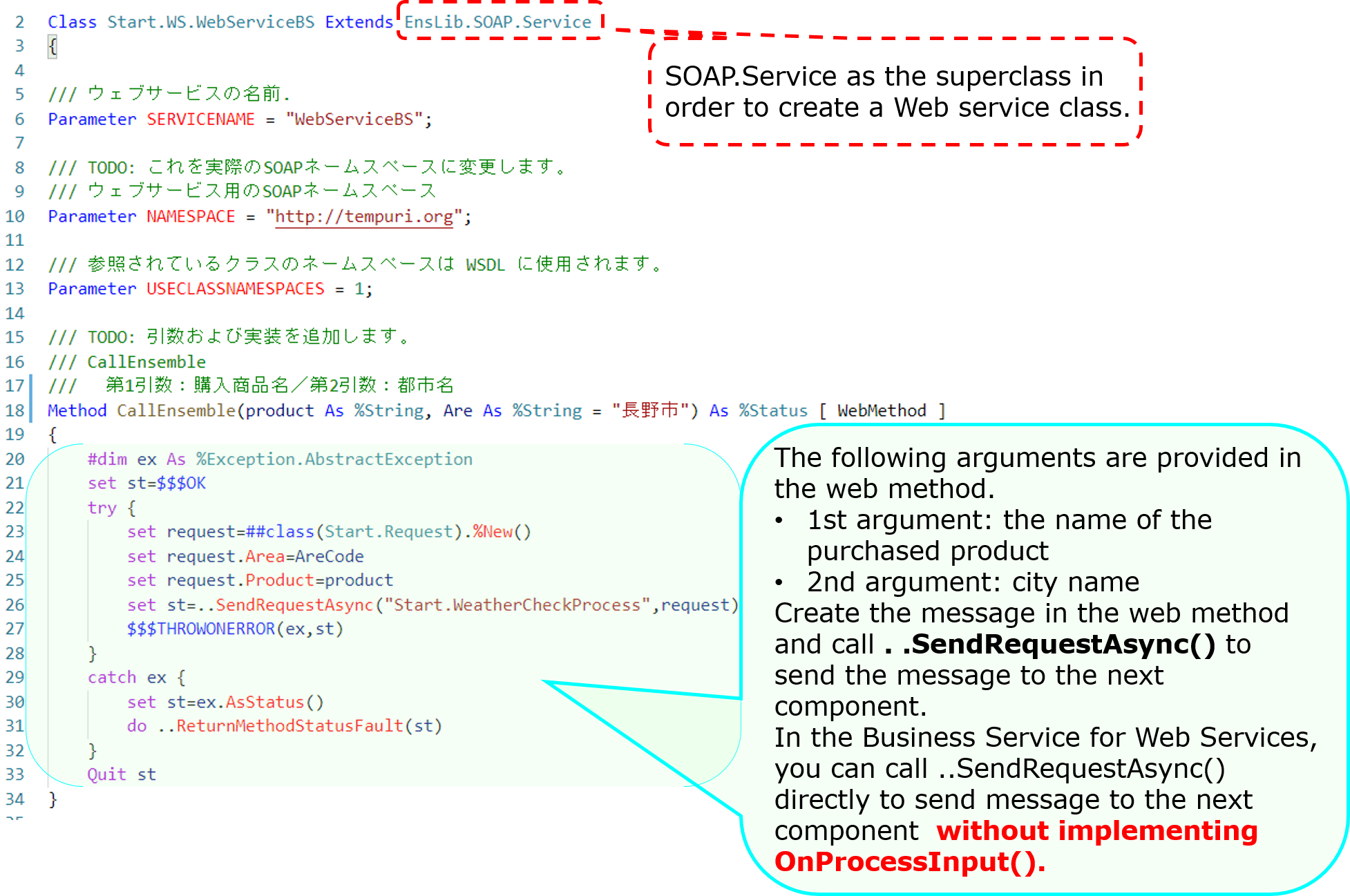
When you define a Web service class, a test screen is created. However, it is not shown by default.
Log in to IRIS (or start a terminal), go to the namespace where the production is located and do the following:
For your reference:Access to the Catalog and Test Pages
Here is a sample code configuration in the setting where the container was started with docker-compose up -d (run in the %SYS namespace)
set $namespace="%SYS"
set ^SYS("Security","CSP","AllowClass","/csp/user/","%SOAP.WebServiceInfo")=1
set ^SYS("Security","CSP","AllowClass","/csp/user/","%SOAP.WebServiceInvoke")=1
【Attention】Please note that the sentence is case-sensitive and should be written with care. Also, depending on the namespace in which the product is used, the specified script changes. The example sentence is written on the assumption that the sample is imported into the USER namespace.If you import the sample code into the ABC namespace, the fourth subscript should be "/csp/abc/."
Once the configuration is complete, go to the following URL:
http://localhost:52773/csp/user/Start.WS.WebServiceBS.cls
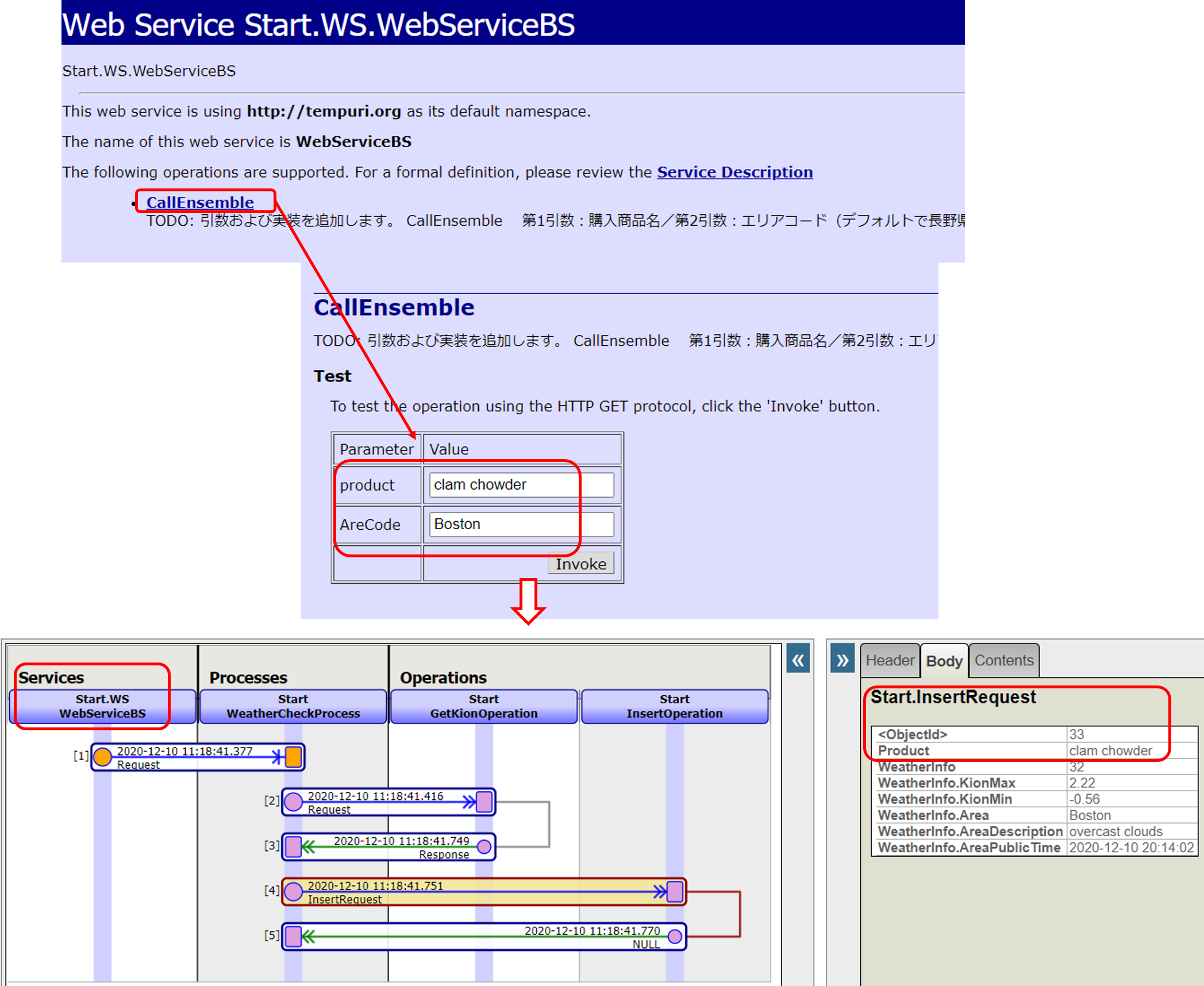
If you want to provide the WSDL to your Web services client, specify WSDL=1 at the end of the following URL
http://localhost:52773/csp/user/Start.WS.WebServiceBS.cls?WSDL
### 3. Business services called by stored procedures or REST without using adapters(Start.NonAdapterBS)
Next, we will introduce the Business Service without adapters (Start.NonAdapterBS).
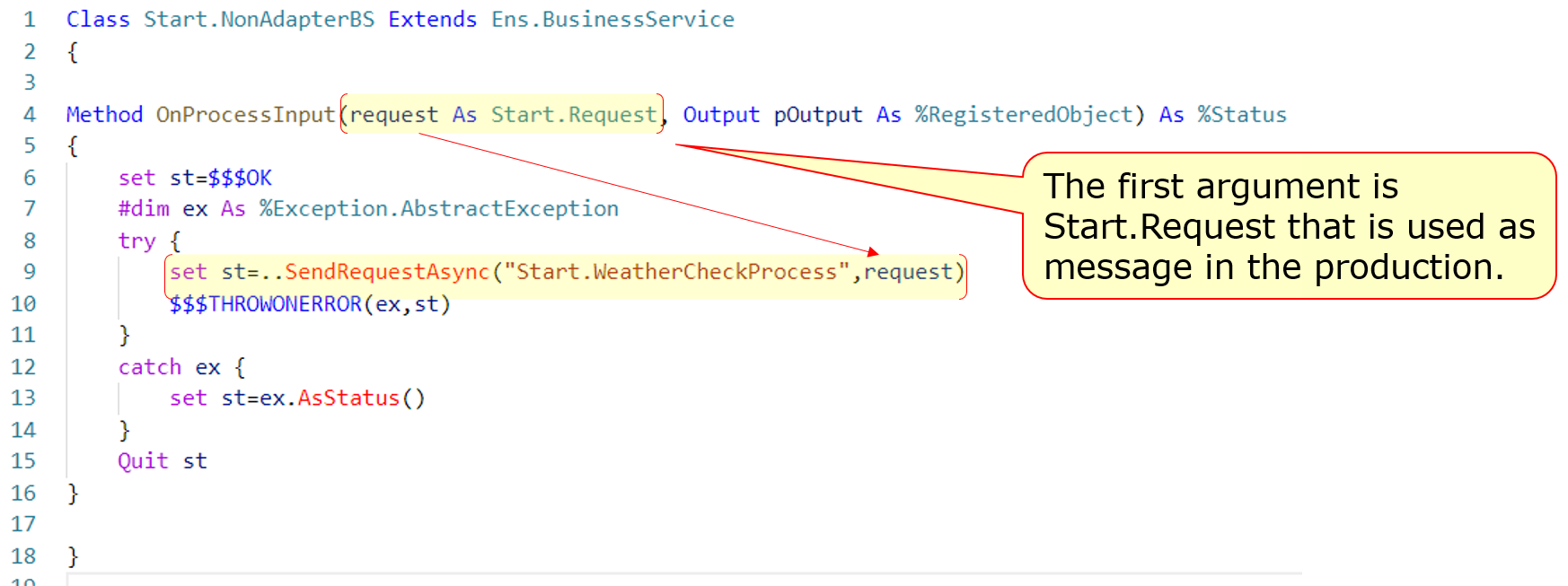
For business services that use adapters, the adapter calls the business service's ProcessInput() method to detect the information.
If you don't use adapters, you can still call the ProcessInput() method, but this method is not public. Therefore, if you implement a business service that does not use adapters, you will need to consider ProcessInput().
The sample utilizes the following two methods:
* Stored procedures(Start.Utils)
* Dispatch Class for REST(Start.REST)→This is the service we ran in this article.
Now, here's an example of a stored procedure.
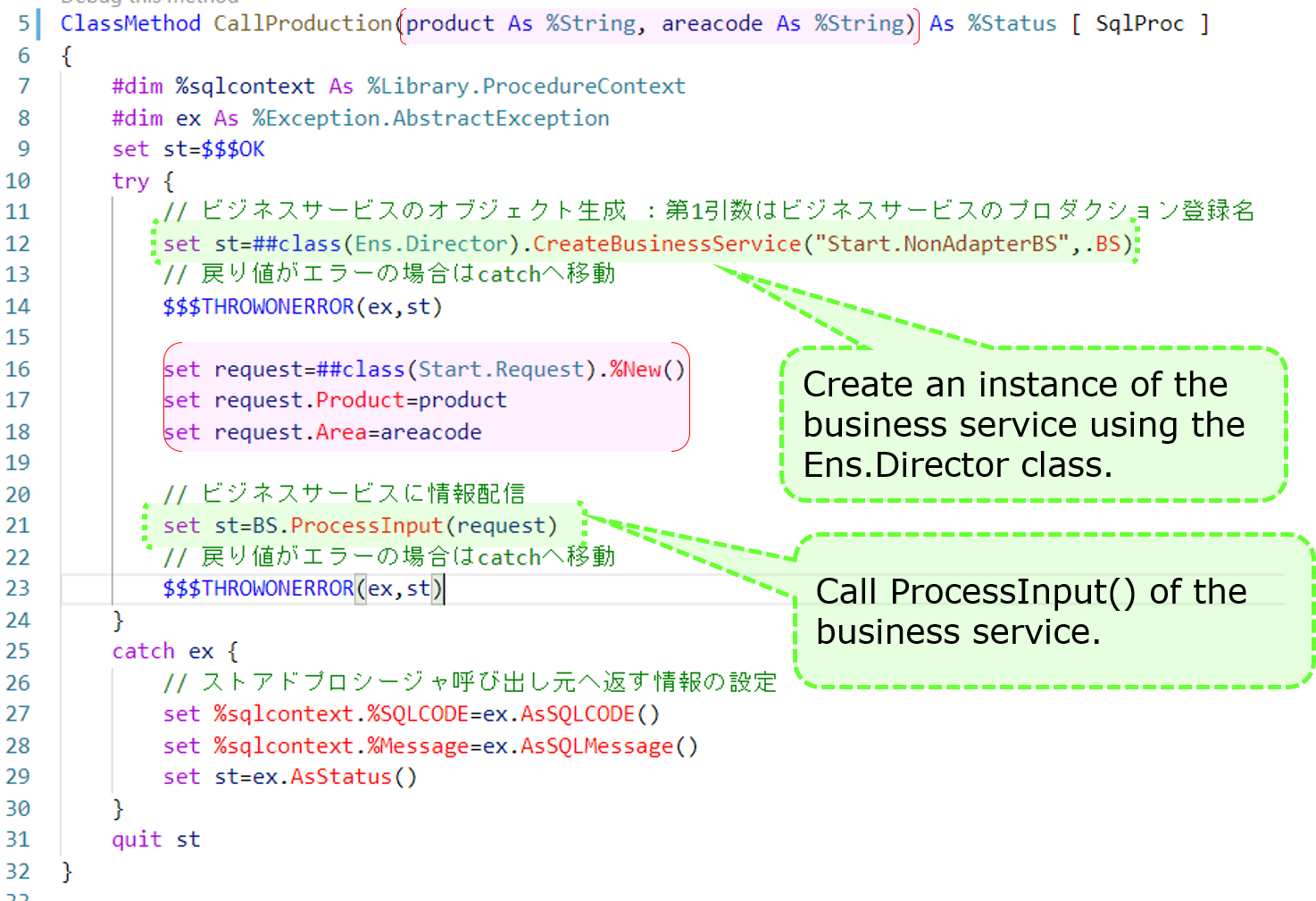
After adding a business service (Start.NonAdapterBS) that does not use adapters to the production (state added in the sample), run the following stored procedure
call Start.Utils_CallProduction('piroshki','Russia')

A resulting trace of the running result is as follows:
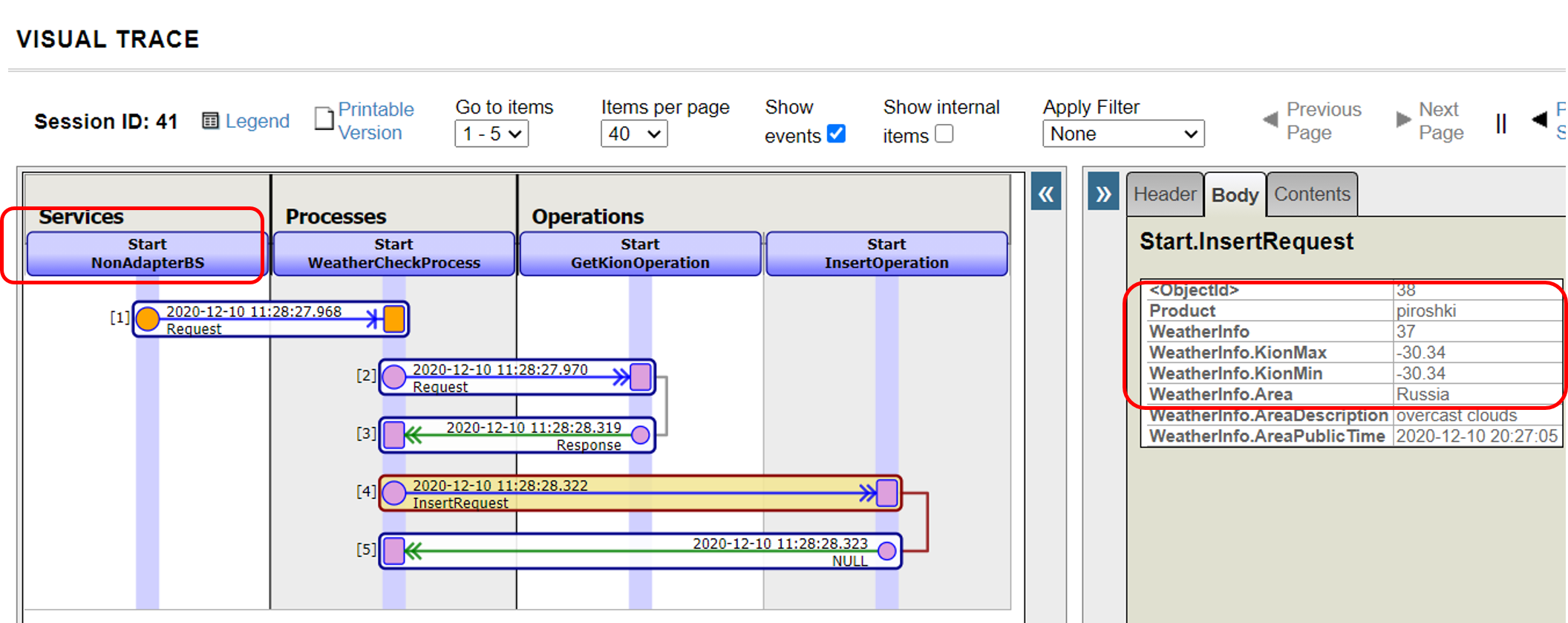
Next, here is an example of creating a dispatch class for REST:
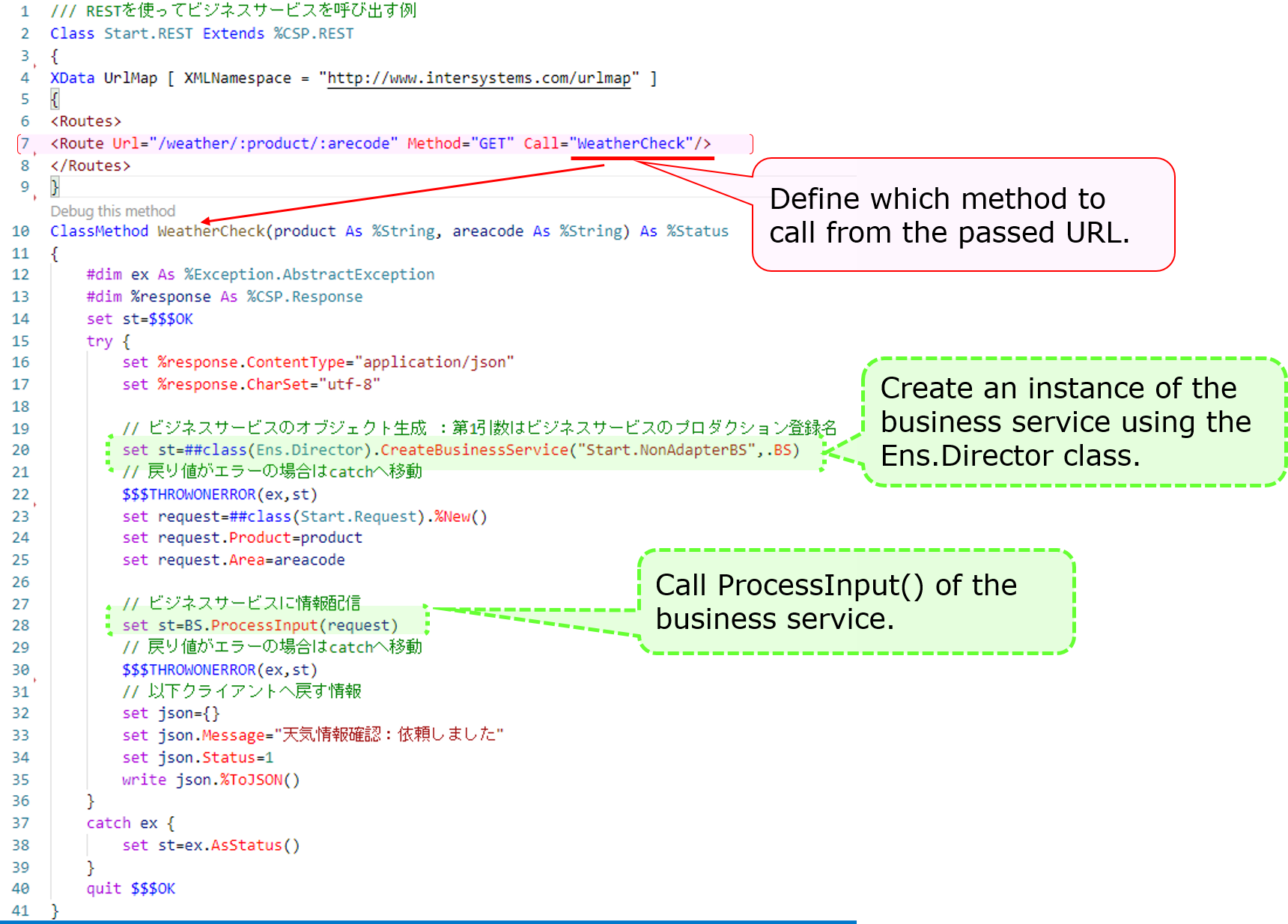
The XML described in the XData Url Map defines which methods are called in response to the URL at the time of the REST call.
The example describes a definition that calls the **WeatherCheck()** method when the URL of the **/weather/first parameter (purchased product name)/ second parameter (name of the city)** are provided in the **GET request**.
```objectscript
```
Then, define the base URL for the above URL in the Management Portal's Web Application Path Settings screen, and it is complete.
See this article for more details on the configuration.
Once it is ready, try to run the information using a business service that allows you to send the REST information.
Example)http://localhost:52773/start/weather/Takoyaki/Osaka

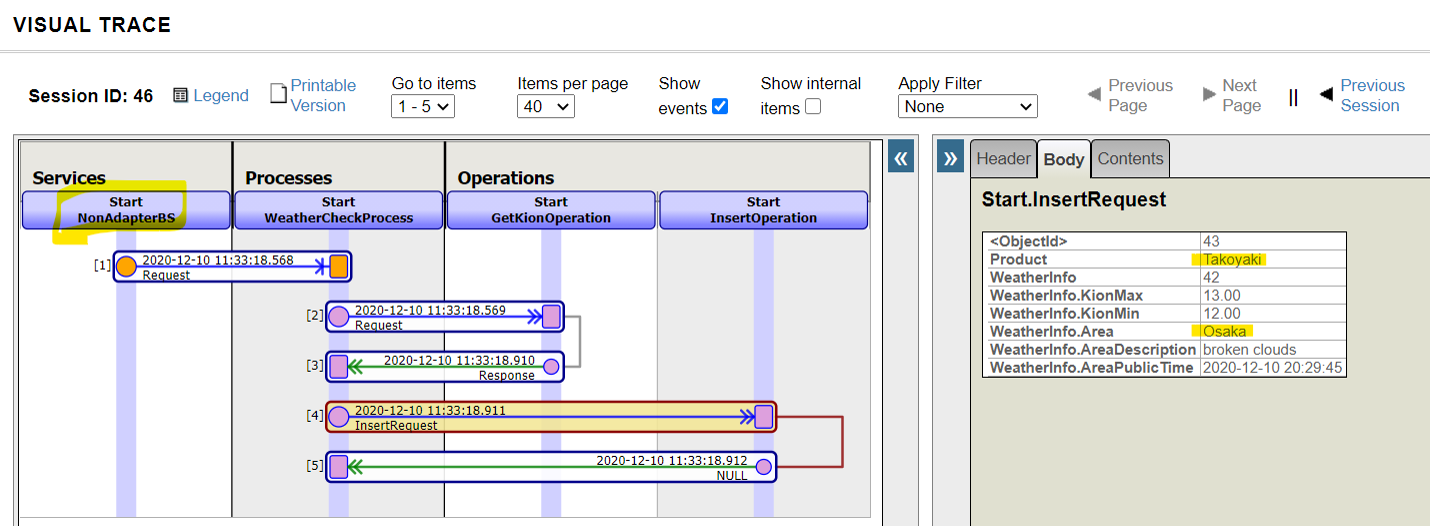
If you do not use an adapter, as ProcessInput() cannot be called directly from outside, we have created an object for the business service in the logic executed through REST or stored procedures (using the CreateBusinessService() method of the Ens.Director class) and called ProcessInput()
If you use an adapter, the adapter detects the input and stores the information in a unique object and passes it to the business service. In contrast, if you don't use an adapter, the rest is pretty much the same, only the difference is in the above-mentioned part of the process.
The business service is simply designed to use the information entered outside IRIS to create request messages and call business components.
Throughout the sample production, we were able to see the following:
Different components play different roles in making a production run (business services, business processes, business operations).
To transmit information between components, use the message.
Messages are stored in the database unless deleted and thus can be traced at any time.
Some adapters simplify the process of around the connection.
These are the basic operations on how to use Interoperability in IRIS.
There are also record maps (see: FAQ TOPIC) and data conversion tools that are useful for input and output of CSV files and other format-specific files.
As well as this series, there is also an article on simple IoT applications developed with InterSystems IRIS using Interoperability. Please check it out.
Besides, IRIS for Health also supports FHIR and HL7 (including SS-MIX2) transmissions.
I would be pleased to explain it in another post. If you have something of interest to share, please leave a comment!
Finally, training courses are also available to learn how to use Interoperability.
If you'd like to take the time to try it out with an instructor, please consider joining one of our training courses!
Announcement
Anastasia Dyubaylo · Mar 19, 2021
Hi Community,
Please welcome the new video on InterSystems Developers YouTube:
⏯ Deploying InterSystems IRIS Solutions into Kubernetes Google Cloud
See how an InterSystems IRIS data platform application is deployed into a Kubernetes cluster, specifically on Google Kubernetes Engine (GKE), using Terraform to create a cluster and a CI/CD GitHub implementation called GitHub Actions to automate deployment steps.
⬇️ Access all code samples here.
🗣 Presenter: @Mikhail.Khomenko, DevOps Engineer
Additional materials to this video you can find in this InterSystems Online Learning Course.
Enjoy watching this video! 👍🏼
Article
Evgeny Shvarov · Jun 24, 2020
Hi Developers!
Suppose you have a persistent class with data and you want to have a simple Angular UI for it to view the data and make CRUD operations.
Recently @Alberto.Fuentes described how to build Angular UI for your InterSystems IRIS application using RESTForms2.
In this article, I want to tell you how you can get a simple Angular UI to CRUD and view your InterSystems IRIS class data automatically in less than 5 minutes.
Let's go!
To make this happen you need:
1. InterSystems IRIS
2. ZPM
3. RESTForms2 and RESTForms2-UI modules.
I'll take a Data.Countries class which I generated and imported via csvgen using this command:
d ##class(community.csvgen).GenerateFromURL("https://raw.githubusercontent.com/datasciencedojo/datasets/master/WorldDBTables/CountryTable.csv",",","Data.Countries"
To make an Angular UI we need to expose REST API for this class, which will service CRUD operations.
Let's use restforms2 module for this.
This command in dockerfile installs restforms2 into IRIS container:
zpm "install restforms2" \
To add a REST API we need to derive the class from Form.Adaptor:
Class Data.Countries Extends (%Library.Persistent, Form.Adaptor)
Add restforms2 parameters to the persistent class to manage the general behavior: sorting parameter, display name, etc:
// Form name, not a global key so it can be anything
Parameter FORMNAME = "Countries";
/// Default permissions
/// Objects of this form can be Created, Read, Updated and Deleted
/// Redefine this parameter to change permissions for everyone
/// Redefine checkPermission method (see Form.Security) for this class
/// to add custom security based on user/roles/etc.
Parameter OBJPERMISSIONS As %String = "CRUD";
/// Property used for basic information about the object
/// By default getObjectDisplayName method gets its value from it
Parameter DISPLAYPROPERTY As %String = "name";
Perfect. Next, we can use restforms2 syntax to let restforms2 know, what properties of the class we want to expose to the CRUD. You can make it adding "DISPLAYNAME =" attribute to the properties, you want to expose into restforms2-ui. Example:
Property code As %Library.String(MAXLEN = 250) [ SqlColumnNumber = 2 ];
Property name As %Library.String(DISPLAYNAME = "Name", MAXLEN = 250) [ SqlColumnNumber = 3 ];
Property continent As %Library.String(DISPLAYNAME = "Continent", MAXLEN = 250) [ SqlColumnNumber = 4 ];
Property region As %Library.String(DISPLAYNAME = "Region", MAXLEN = 250) [ SqlColumnNumber = 5 ];
Property surfacearea As %Library.Integer(DISPLAYNAME = "Surface Area", MAXVAL = 2147483647, MINVAL = -2147483648) [ SqlColumnNumber = 6, SqlFieldName = surface_area ];
Property independenceyear As %Library.Integer(DISPLAYNAME = "Independence Year", MAXVAL = 2147483647, MINVAL = -2147483648) [ SqlColumnNumber = 7, SqlFieldName = independence_year ];
Great! Now lets introduce the UI layer. This command in dockerfile installs restforms2-ui, which is Angular UI for Restform2:
zpm "install restforms2-ui" \
That's it! Let' examine the UI for your class, which you can find in the URL server:port/restforms2-ui:
RESTForms goes with test classes Person and Company - and you can use it to examine the features of restformsUI. Currently It can edit string, number, boolean, date and look-up fields.
You can test all this on your laptop, if clone and build this repository:
docker-compose up -d --build
And then open the URL:
localhost:port/restforms2-ui/index.html
or if you use VSCode, select this menu item:
Happy coding and stay tuned! It's great! I tried the application, and I liked the interface and how easy it is to create a simple CRUD using RESTForms. 💡 This article is considered as InterSystems Data Platform Best Practice. Love the accelerator concept for quick and easy CRUD :)
Announcement
Anastasia Dyubaylo · Sep 29, 2020
Hey Developers,
New demo show by InterSystems Manager @Amir.Samary is already on InterSystems Developers YouTube:
⏯ InterSystems IRIS: Kafka, Schema Normalization and Service Enablement
Demo of InterSystems IRIS with Kafka, Schema Registry, AVRO and Schema Migration.
This demo allows you to show:
A Bank Simulator generating AVRO messages and sending them over Kafka to InterSystems IRIS
InterSystems IRIS Multi-model capabilities (AVRO, JSON, Objects, SQL and MDX)
How InterSystems IRIS can transform the AVRO object into a canonical structure using transformations and lookups
How InterSystems IRIS can orchestrate this work and start a human workflow in case of a problem during the transformations
How InterSystems IRIS can provide bidirectional data lineage (from source to canonical and vice-versa)
How InterSystems IRIS pull new schemas from a Kafka Schema Registry and generate the data structures automatically to support schema evolution
This demo uses Confluent's Kafka and their docker-compose sample
⬇️ Kafka Demo with InterSystems IRIS on Open Exchange
This demo can be also found at https://github.com/intersystems-community/irisdemo-demo-kafka
Enjoy watching the video! 👍🏼
Announcement
Olga Zavrazhnova · Feb 26, 2021
Hi Developers,A new exciting challenge introduced for Global Masters members of "Advocate" level and above: we invite you to record a 30-60 sec video with an answer to our question:
➥ What is the value of InterSystems IRIS to you?
🎁 Reward of your choice for doing the interview: $50 Gift Card (VISA/Amazon) or 12,000 points!
Follow this direct link to the challenge for more information. Please note that the link will work for GM members of "Advocate" level and above. More about GM levels you can read here.
We would love to hear from you!
See you on the Global Masters Advocate Hub today!
Announcement
Stefan Wittmann · Jul 1, 2020
GA releases are now published for the 2020.2 version of InterSystems IRIS, IRIS for Health, and IRIS Studio!
A full set of containers for these products are available from the WRC Software Distribution site, including community editions of InterSystems IRIS and IRIS for Health.
The build number for these releases is 2020.2.0.211.0.
InterSystems IRIS Data Platform 2020.2 provides an important security update with the following enhancements:
Support for TLS 1.3
Support for SHA-3
InterSystems IRIS for Health 2020.2 includes all of the enhancements of InterSystems IRIS. In addition, this release includes:
FHIR R4 Data transformations
New configuration UI for the FHIR Server
Support for IHE RMU Profile
IHE Connectathon Updates
As this is a CD (Continuous Delivery) release, many customers may want to know the differences between 2020.2 and 2020.1. These are listed in the release notes:
InterSystems IRIS 2020.2 release notes
IRIS for Health 2020.2 release notes
Documentation can be found here:
InterSystems IRIS 2020.2 documentation
IRIS for Health 2020.2 documentation
InterSystems IRIS Studio 2020.2 is a standalone development image supported on Microsoft Windows. It works with InterSystems IRIS and IRIS for Health version 2020.2 and below, as well as with Caché and Ensemble.
The platforms on which InterSystems IRIS and IRIS for Health 2020.2 are supported for production and development are detailed in the Supported Platforms document. Hi Stefan,
I'm not seeing the 2020.2 distributions listed for the full kits on the WRC site. Do you know when they will be available? Hi @Jeffrey.Drumm ,
thanks for the catch, the wording was not clear and I have corrected the statement. 2020.2 is a CD release, which only contains container images, not full kits.
Thanks,
Stefan Full kits will not be available for this release? Correct. @Jeffrey.Drumm - please see the article on how InterSystems IRIS will be released:
https://community.intersystems.com/post/new-release-cadence-intersystems-irisThis may help to clear up some confusion. The Community Edition images for IRIS and IRIS for Health are now available in the Docker Store. And we now offer the Community Edition for both x64 and ARM64 architectures. Try them out!
InterSystems IRIS:
docker pull store/intersystems/iris-community:2020.2.0.211.0
docker pull store/intersystems/iris-community-arm64:2020.2.0.211.0
InterSystems IRIS for Health:
docker pull store/intersystems/irishealth-community:2020.2.0.211.0
docker pull store/intersystems/irishealth-community-arm64:2020.2.0.211.0 Thank you for the clarification. I'm in the middle of a Cache/Ensemble on SUSE -> IRIS for Health on RHEL migration and would prefer to be at the latest available release prior to go-live. But I guess I am, per the release schedule. Great news about ARM support.
As tagged image can be provided with several architectures (example with 4) is there a reason why we separate the tags into community and community-arm? As I understand, this functionality (as well as the ability to use default image tags such as 'openjdk' vs '/store/intersystems/...') is only available for Official Images (https://docs.docker.com/docker-hub/official_images/) that are published by Docker. We are a verified publisher, and our images are Docker certified, but they are not published and maintained by Docker. Here's a Docker Hub image (not official, not certified) with multiple architectures.
Here's info on publishing multi-arch images. Some more info.
manifest command was successfully merged into docker codebase so it seems possible now. Are there any plans to bring the FHIR capabilities to the EM channel - 2020.1.x? While I appreciate the difference between CD/EM models, these FHIR updates could be critical for those of us that have to stick to the EM model (particularly the FHIR R4 and FHIR Server changes) without needing to wait until a 2021.x release. There are no plans to integrate latest FHIR features into EM (Extended Maintenance) releases at this time, but we will be sure to let everyone know should our release plans change in the future.
Thanks,Craig
Article
Eduard Lebedyuk · Aug 3, 2020
InterSystems IRIS currently limits classes to 999 properties.
But what to do if you need to store more data per object?
This article would answer this question (with the additional cameo of Community Python Gateway and how you can transfer wide datasets into Python).
The answer is very simple actually - InterSystems IRIS currently limits classes to 999 properties, but not to 999 primitives. The property in InterSystems IRIS can be an object with 999 properties and so on - the limit can be easily disregarded.
Approach 1.
Store 100 properties per serial property. First create a stored class that stores a hundred properties.
Class Test.Serial Extends %SerialObject
{
Property col0;
...
Property col99;
}
And in your main class add as much properties as you need:
Class Test.Record Extends %Persistent
{
Property col00 As Test.Serial;
Property col01 As Test.Serial;
...
Property col63 As Test.Serial;
}
This immediately raises your limit to 99900 properties.
This approach offers uniform access for all properties via SQL and object layers (we always know property reference by it's number).
Approach 2.
One $lb property.
Class Test.Record Extends %Persistent
{
Property col As %List;
}
This approach is simpler but does not provide explicit column names.
Use SQL $LIST* Functions to access list elements.
Approach 3.
Use Collection (List Of/Array Of) property.
Class Test.Record Extends %Persistent
{
Property col As List Of %Integer;
}
This approach also does not provide explicit column names for individual values (but do you really need it?). Use property parameters to project the property as SQL column/table.
Docs for collection properties.
Approach 4.
Do not create properties at all and expose them via SQL Stored procedure/%DispatchGetProperty.
Class Test.Record Extends %Persistent
{
Parameter GLVN = {..GLVN("Test.Record")};
/// SELECT Test_Record.col(ID, 123)
/// FROM Test.Record
///
/// w ##class(Test.Record).col(1, )
ClassMethod col(id, num) As %Decimal [ SqlProc ]
{
#define GLVN(%class) ##Expression(##class(Test.Record).GLVN(%class))
quit $lg($$$GLVN("Test.Record")(id), num + 1)
}
/// Refer to properties as: obj.col123
Method %DispatchGetProperty(Property As %String) [ CodeMode = expression ]
{
..col(..%Id(), $e(Property, 4, *))
}
/// Get data global
/// w ##class(Test.Record).GLVN("Test.Record")
ClassMethod GLVN(class As %Dictionary.CacheClassname = {$classname()}) As %String
{
return:'$$$comClassDefined(class) ""
set strategy = $$$comClassKeyGet(class, $$$cCLASSstoragestrategy)
return $$$defMemberKeyGet(class, $$$cCLASSstorage, strategy, $$$cSDEFdatalocation)
}
The trick here is to store everything in the main $lb and use unallocated schema storage spaces to store your data. Here's an article on global storage.
With this approach, you can also easily transfer the data into Python environment with Community Python Gateway via the ExecuteGlobal method.
This is also the fastest way to import CSV files due to the similarity of the structures.
Conclusion
999 property limit can be easily extended in InterSystems IRIS.
Do you know other approaches to storing wide datasets? If so, please share them!
The question is how csvgen could be upgraded to consume csv files with 1000+ cols. While I always advertise CSV2CLASS methods for generic solutions, wide datasets often possess an (un)fortunate characteristic of also being long.
In that case custom object-less parser works better.
Here's how it can be implemented.
1. Align storage schema with CSV structure
2. Modify this snippet for your class/CSV file:
Parameter GLVN = {..GLVN("Test.Record")};
Parameter SEPARATOR = ";";
ClassMethod Import(file = "source.csv", killExtent As %Boolean = {$$$YES})
{
set stream = ##class(%Stream.FileCharacter).%New()
do stream.LinkToFile(file)
kill:killExtent @..#GLVN
set i=0
set start = $zh
while 'stream.AtEnd {
set i = i + 1
set line = stream.ReadLine($$$MaxStringLength)
set @..#GLVN($i(@..#GLVN)) = ..ProcessLine(line)
write:'(i#100000) "Processed:", i, !
}
set end = $zh
write "Done",!
write "Time: ", end - start, !
}
ClassMethod ProcessLine(line As %String) As %List
{
set list = $lfs(line, ..#SEPARATOR)
set list2 = ""
set ptr=0
// NULLs and numbers handling.
// Add generic handlers here.
// For example translate "N/A" value into $lb() if that's how source data rolls
while $listnext(list, ptr, value) {
set list2 = list2 _ $select($g(value)="":$lb(), $ISVALIDNUM(value):$lb(+value), 1:$lb(value))
}
// Add specific handlers here
// For example convert date into horolog in column4
// Add %%CLASSNAME
set list2 = $lb() _ list2
quit list2
} Thanks, Ed!Could you make a PR? I have no concrete ideas on how to automate this.
This is a more case-by-case basis. After more than 42 years of M-programming and in total of 48 years of programming experience I would say, if you need a class with about 1000 or more properties than something is wrong with your (database) design. There is nothing more to say. Period. Wide datasets are fairly typical for:
Industrial data
IoT
Sensors data
Mining and processing data
Spectrometry data
Analytical data
Most datasets after one-hot-encoding applied
NLP datasets
Any dataset where we need to raise dimensionality
Media featuresets
Social Network/modelling schemas
I'm fairly sure there's more areas but I have not encountered them myself.
Recently I have delivered a PoC with classes more than 6400 columns wide and that's where I got my inspiration for this article (I chose approach 4).
@Renato.Banzai also wrote an excellent article on his project with more than 999 properties.
Overall I'd like to say that a class with more than 999 properties is a correct design in many cases. You probably right for a majority of tasks. But how do you manage with AI tasks which NEED to manage thousands of features of entities? And features are properties/fields from data storage perspective.
Anyway, I'm really curious how do you deal with AI/ML tasks in IRIS or Caché. Entity–attribute–value model is usually used for this purpose.
I have already written about this at the time: SQL index for array property elements. That's good and well for sparse datasets (where say you have a record with 10 000 possible attributes but on average only 50 are filled).
EAV does not help in dense cases where every record actually has 10 000 attributes. My EAV implementation is the same as your Approach 3, so it will work fine even with fully filled 4.000.000 attributes.
Since the string has a limit of 3,641,144, approaches with serial and %List are dropped.
All other things being equal, everything depends on the specific technical task: speed, support for Objects/SQL, the ability to name each attribute, the number of attributes, and so on. The approach 1 doesn't "raises your limit to 99900 properties" but rather to 6600 properties.
You can test it through large.utils.cls
w ##class(large.utils).init(66,100) deleting large.serial100creating large.serial100compiling large.serial100
Compilation started on 07/31/2023 14:48:16Compiling class large.serial100Compiling routine large.serial100.1Compilation finished successfully in 0.218s.
creating large.c66compiling large.c66
Compilation started on 07/31/2023 14:48:16Compiling class large.c66Compiling table large.c66Compiling routine large.c66.1Compilation finished successfully in 8.356s.
1w ##class(large.utils).init(67,100)deleting large.serial100creating large.serial100compiling large.serial100
Compilation started on 07/31/2023 14:48:27Compiling class large.serial100Compiling routine large.serial100.1Compilation finished successfully in 0.213s.
creating large.c67compiling large.c67
Compilation started on 07/31/2023 14:48:27Compiling class large.c67Compiling table large.c67Compiling routine large.c67.1ERROR #5002: ObjectScript error: <MAXSTRING>CompileRtns+286^%occRoutineERROR #5002: ObjectScript error: <NOROUTINE>DescribePhase2+9^%occSysDescriptor *large.c67.1Detected 2 errors during compilation in 6.896s.
0 a(<MAXSTRING>CompileRtns+286^%occRoutineÛCompileRtns+286^%occRoutine IRISAPP³e^ReturnError+2^%occSystem^1!e^CompileList+229^%occCompile^1e^CompileList+23^%apiOBJ^1e^Compile+1^%apiOBJ^1e^Compile+1^%SYSTEM.OBJ.1^1^init+50^large.utils.1^1e^^^0K0 G¦ large.c67/ IRISAPP#!e^CompileRtns+388^%occRoutine^1IRISAPP> I guess we are hitting some other limit.
I went with approach 4 myself. I fully agree with Julius.Any class that exceeds 100 properties is dead wrong.We're not talking tables (relational) (and even then it's wrong) but OO design, which doesn't seem to be much in fashion these days.Redesign your solution
Announcement
Anastasia Dyubaylo · Oct 26, 2020
Hey Community,
We're pleased to invite you all to the Virtual Summit 2020 session dedicated to InterSystems online programming contests, best winning projects, and their developers! Please join:
⚡️ "Best applications of InterSystems programming contest series: Best IntegratedML, FHIR, REST API, Native API, ObjectScript solutions" session ⚡️
Please check the details below.
We will talk about the series of online contests for InterSystems developers. This session will focus on the contest winners and the top applications. Our developers will share their experience of participating in the exiting InterSystems coding marathon and will show demos of their winning projects.
Speakers: 🗣 @Anastasia.Dyubaylo, Community Manager, InterSystems 🗣 @Henrique, System Management Specialist / Database Administrator, Sao Paulo Federal Court🗣 @José.Pereira, Business Intelligence Developer, Shift Consultoria e Sistemas Ltda🗣 @henry, System Analyst, BPlus Tecnologia🗣 @Dmitry.Maslennikov, Co-founder, CTO and Developer Advocate, CaretDev Corp🗣 @Renato.Banzai, Machine Learning Engineer Coordinator, Itaú Unibanco
Date & Time:
➡️ Day 1: Tuesday, October 27 (Boston starts Monday, October 26)
APAC
UTC Time
Boston Time
Best Applications of InterSystems Programming Contest Series
2:50 AM
10:50 PM
NA/LATAM/EMEA
UTC Time
Boston Time
Best Applications of InterSystems Programming Contest Series
3:50 PM
11:50 PM
So!
We will be happy to answer your questions in a virtual chat on the conference platform – please join! We'll start in 15 minutes! Please join!
📍 https://intersystems.6connex.com/event/virtual-summit/en-us/contents/433176/share?rid=FocusSessions&nid=804450 💥 Join us NOW here: https://intersystems.6connex.com/event/virtual-summit/en-us/contents/433253/share?rid=FocusSessions&nid=804450
Article
John Murray · Oct 27, 2020
Now that 1.0 has shipped and is featuring in various sessions at Virtual Summit 2020 it seems like a good time to offer some guidance on how to report problems.
InterSystems ObjectScript for VS Code consists of three collaborating VS Code extensions. For ease of installation and management there's a fourth entity, the InterSystems ObjectScript Extension Pack. It's a great way to get started with minimum clicks, and handy to have even if you have already installed the other extensions.
This modular architecture also means there are three different GitHub repositories where issues can be created. Fortunately VS Code itself helps with the task. Here's how to use it:
1. From the Help menu in VS Code choose Report Issue. Alternatively, open the Command Palette (I typically do this by pressing the F1 key) and run Help: Report Issue... (Pro Palette Tip: try typing just hri and see how fast it gets you to the right command)
2. A dialog like this appears:
3. Use the first field to classify your issue:
Bug Report
Feature Request
Performance Issue
4. In the second field pick "An extension".
5. The third dropdown lets you pick one of your installed extensions. You can also type a few characters to find the right entry. For example, isls quickly selects "InterSystems Language Server" for me.
Which one to choose? Here's a rough guide:
InterSystems Language Server
code colo(u)ring
Intellisense
InterSystems ObjectScript
export, import and compile
ObjectScript Explorer (browsing namespace contents)
direct server-side editing using isfs:// folders in a workspace
integration with server-side source control etc
InterSystems Server Manager
password management in local keychain
definition and selection of entries in `intersystems.servers`
If you can't decide, pick InterSystems ObjectScript.
6. Type a descriptive one-line summary of your issue. The dialog may offer a list of existing issues which could be duplicates. If you don't find one that covers yours, proceed.
7. Begin to enter details. At this stage I usually type just one character, then click "Preview on GitHub" to launch a browser page where I can use the familiar GH issue UI to complete my report. Tips for use there:
Paste images from your clipboard directly into the report field on GH. For hard-to-describe issues an animated GIF gets bonus points.
Link to other issues by prefixing the target number with #
Remember that whatever you post here is visible to anyone on the Internet. Mask/remove confidential information. Be polite.
8. When you are happy with what you have written (tip - use the Preview tab) click "Submit new issue".
Using Help: Report Issue... means your version numbers are automatically added.
Announcement
Anastasia Dyubaylo · Oct 27, 2020
Hey Developers,
We remind you about a great opportunity to make a live conversation with InterSystems Product Managers Team on Live Q&A Sessions at Virtual Summit 2020!
🗓 TODAY at 12:40 PM EDT at https://intersystems.6connex.com/event/virtual-summit/en-us/contents/434370/share?rid=FocusSessions&nid=804450
And now we've added more options to make it even easier for you to ask questions upfront:
✅ Submit your questions in the comments to this post
✅ Submit your question to our Discord Channel: discord.gg/WqVjtD
✅ Submit your questions to VS2020questions@InterSystems.com
✅ Send your question personally to @Anastasia.Dyubaylo or @Evgeny.Shvarov in Direct Messages on the community
✅ Submit your question to Q&A Chat on the conference platform during the session
Note: We will pass all your questions to the PM team, and you'll receive answers during the Live Q&A Sessions.
And let me introduce the whole InterSystems Product Managers Team:
@Jeffrey.Fried, Director of Product Managers @Andreas.Dieckow, Principal Product Manager@Robert.Kuszewski, Product Manager - Developer Experience @Raj.Singh5479, Product Manager - Developer Experience @Carmen.Logue, Product Manager - AI and Analytics @tomd, Product Specialist - Machine Learning @Steven.LeBlanc, Product Specialist - Cloud Operations @Patrick.Jamieson3621, Product Manager - Health Informatics Platform@Benjamin.DeBoe, Product Manager @Stefan.Wittmann, Product Manager@Luca.Ravazzolo, Product Manager @Craig.Lee, Product Specialist
So!
Please don't hesitate to ask your questions! Our PM team will be happy to answer you!
➡️ Our Live Q&A Sessions last from November 27 to 29! Schedule in this post. Please join us now!
📍 https://intersystems.6connex.com/event/virtual-summit/en-us/contents/433280/share?rid=FocusSessions&nid=804450 🗓 TODAY at 12:40 PM EDT at https://intersystems.6connex.com/event/virtual-summit/en-us/contents/434195/share?rid=FocusSessions&nid=804450
Please feel free to submit your questions to our PMs team! Don't miss today's Live Q&A Session:
🗓 TODAY at 12:40 PM EDT at https://intersystems.6connex.com/event/virtual-summit/en-us/contents/434370/share?rid=FocusSessions&nid=804450
Don't hesitate to ask your questions!
Announcement
Benjamin De Boe · Oct 19, 2020
Preview releases are now available for the 2020.4 version of InterSystems IRIS, IRIS for Health and IRIS Studio. As this is a preview release, we are eager to learn from your experiences with this new release ahead of its General Availability next month.InterSystems IRIS Data Platform 2020.4 makes it even easier to develop, deploy and manage augmented applications and business processes that bridge data and application silos. It has many new capabilities including:
Enhancements for application and interface developers, including:
Support for Java SE 11 LTS, both when using Oracle OpenJDK and AdoptOpenJDK
Support for Connection Pooling for JDBC
A new "foreach" action in routing rules for segmented virtual documents
Enhancements for database and system administrators, including:
ICM now supports deploying System Alerting and Monitoring (SAM) and InterSystems API Manager (IAM)
Extensions to our SQL syntax for common administrative tasks
Simplified deployment for InterSystems Reports
InterSystems IRIS for Health 2020.4 includes all of the enhancements of InterSystems IRIS. In addition, this release includes
Enhanced FHIR support, including support for FHIR profiles
Support for the RMD IHE profile
DataGate support in the HL7 Migration Tooling
More details on these features can be found in the product documentation:
InterSystems IRIS 2020.4 documentation and release notes
InterSystems IRIS for Health 2020.4 documentation and release notes
As this is a CD release, it is only available in OCI (Open Container Initiative) a.k.a. Docker container format. Container images are available for OCI compliant run-time engines for Linux x86-64 and Linux ARM64, as detailed in the Supported Platforms document.
Container images for the Enterprise Edition and all corresponding components are available from the InterSystems Container Registry using the following commands:
docker pull containers.intersystems.com/intersystems/iris:2020.4.0.524.0
docker pull containers.intersystems.com/intersystems/irishealth:2020.4.0.524.0
For a full list of the available images, please refer to the ICR documentation.
Container images for the Community Edition can also be pulled from the Docker store using the following commands:
docker pull store/intersystems/iris-community:2020.4.0.524.0
docker pull store/intersystems/iris-community-arm64:2020.4.0.524.0
docker pull store/intersystems/irishealth-community:2020.4.0.524.0
docker pull store/intersystems/irishealth-community-arm64:2020.4.0.524.0
Alternatively, tarball versions of all container images are available via the WRC's preview download site.
InterSystems IRIS Studio 2020.4 is a standalone development image supported on Microsoft Windows. It works with InterSystems IRIS and IRIS for Health version 2020.4 and below, as well as with Caché and Ensemble. It can be downloaded via the WRC's preview download site.
The build number for this preview release is 2020.4.0.524.0 (updated from 2020.4.0.521.0 on Nov 2nd) And we updated the images with ZPM 0.2.7 too:
intersystemsdc/iris-community:2020.3.0.221.0-zpm
intersystemsdc/iris-community:2020.4.0.524.0-zpm
intersystemsdc/iris-ml-community:2020.3.0.302.0-zpm
intersystemsdc/irishealth-community:2020.3.0.221.0-zpm
intersystemsdc/irishealth-community:2020.4.0.524.0-zpm
intersystemsdc/iris-community-arm64:2020.4.0.524.0-zpm
intersystemsdc/irishealth-community-arm64:2020.4.0.524.0-zpm
And to launch IRIS do:
docker run --rm --name my-iris -d --publish 9091:1972 --publish 9092:52773 intersystemsdc/iris-community:2020.3.0.221.0-zpm
docker run --rm --name my-iris -d --publish 9091:1972 --publish 9092:52773 intersystemsdc/iris-community:2020.4.0.524.0-zpm
docker run --rm --name my-iris -d --publish 9091:1972 --publish 9092:52773 intersystemsdc/iris-ml-community:2020.3.0.302.0-zpm
docker run --rm --name my-iris -d --publish 9091:1972 --publish 9092:52773 intersystemsdc/irishealth-community:2020.3.0.221.0-zpm
docker run --rm --name my-iris -d --publish 9091:1972 --publish 9092:52773 intersystemsdc/irishealth-community:2020.4.0.524.0-zpm
docker run --rm --name my-iris -d --publish 9091:1972 --publish 9092:52773 intersystemsdc/iris-community-arm64:2020.4.0.524.0-zpm
docker run --rm --name my-iris -d --publish 9091:1972 --publish 9092:52773 intersystemsdc/irishealth-community-arm64:2020.4.0.524.0-zpm
And for terminal do:
docker exec -it my-iris iris session IRIS
and to start the control panel:
http://localhost:9092/csp/sys/UtilHome.csp
To stop and destroy container do:
docker stop my-iris Hi,
SuperServer port since 2020.3 is 1972 :
docker run --rm --name my-iris -d --publish 9091:1972 --publish 9092:52773 intersystemsdc/iris-community:2020.3.0.221.0-zpm
docker run --rm --name my-iris -d --publish 9091:1972 --publish 9092:52773 intersystemsdc/iris-community:2020.4.0.521.0-zpm
docker run --rm --name my-iris -d --publish 9091:1972 --publish 9092:52773 intersystemsdc/irishealth-community:2020.3.0.221.0-zpm
docker run --rm --name my-iris -d --publish 9091:1972 --publish 9092:52773 intersystemsdc/irishealth-community:2020.4.0.521.0-zpm Thanks again, Guillaume!
fixed! Thank's for this! UPDATE: We uploaded an updated version of our 2020.4 preview release, including a small number of additional enhancements in the broader SQL area that missed the boat for the scheduled preview release date. These features meet the quality requirements for inclusion in the GA release later this month so we thought it was worthwhile sharing them in preview mode for users to try ahead of time.
The new build number is 524, up from 521. The new images have been posted on the ICR, Docker Store and WRC locations as described above and the docker pull scripts have been updated.
As always, we're looking forward to your feedback! ZPM images are updated with a new IRIS 2020.4.0.524.0 build. Hi -
Note that using the ZPM images to build a HealthShare Foundation namespace (interoperability enabled database and namespace), using the HealthShare -> Installer wizard -> Configure Foundation ; .
OR you can try this, using this line:
ZN "HSLIB"DO ##class(HS.HC.Util.Installer).InstallFoundation("MYNAMESPACE")
will hang mid-way.
However, above operations complete successfully using the standard, non-ZPM enhanced builds.I haven't tested any other functionality.
Steve Thanks, Steve! Just to clarify: this issue is related to ZPM-enabled IRIS for Health images, right? Filed the issue. yes
Just tested on 2020.4 zpm enabled:
HSLIB>DO ##class(HS.HC.Util.Installer).InstallFoundation("HSFOUNDATION")
HS.Util.Installer.Foundation:Install User 'irisowner' has %Admin_Manage:USE privilege
HS.Util.Installer.Foundation:Install tComponent Foundation = HSFOUNDATION
HS.Util.Installer.Foundation:Install About to Create Database HSFOUNDATION
HS.Util.Installer.Foundation:Install Create IRIS.DAT in HSFOUNDATION
HS.Util.Installer.Foundation:Install Made Namespace HSFOUNDATION
HS.HC.Util.Installer:EnableEnsemble Created Ensemble Mappings
HS.HC.Util.Installer:EnableEnsemble Configuration Loaded
HS.HC.Util.Installer:EnableEnsemble Compiling Ensemble DeepSee Dashboard
HS.HC.Util.Installer:EnableEnsemble Ensemble Enabled
HS.Util.Installer.Foundation:SecureInstall Added Package mappings HS,HSMOD,SchemaMap
HS.Util.Installer.Foundation:SecureInstall Added include mappings HSMOD.*,SchemaMap*
HS.Util.Installer.Foundation:Install Created Portal CSP app
HS.Util.Installer.Foundation:CreateProduction Compiled template HSFOUNDATIONPKG.FoundationProduction
HS.Util.Installer.Foundation:AdditionalSetup Set Credential HS_Services
Running HS.Util.Installer.Kit.PostInstall.SetupOIDRegistry:RunHub(HSFOUNDATION)
Ran HS.Util.Installer.Kit.PostInstall.SetupOIDRegistry:RunHub with status OK
Running HS.Util.Installer.Kit.PostInstall.AssignAuthTypes:RunHub(HSFOUNDATION)
Ran HS.Util.Installer.Kit.PostInstall.AssignAuthTypes:RunHub with status OK
HS.Util.Installer.Foundation:SecureInstall Recompiled XML extension classesSaving hl7.fhir.r3.core@3.0.2
Saving hl7.fhir.r4.core@4.0.1
Saving hl7.fhir.us.core@3.1.0
Load Resources: hl7.fhir.r3.core@3.0.2
Load Resources: hl7.fhir.r4.core@4.0.1
Resource Used in Multiple Packages: http://healthit.gov/nhin/purposeofuse|2.0(hl7.fhir.r3.core@3.0.2,hl7.fhir.r4.core@4.0.1)
Resource Used in Multiple Packages: http://dicom.nema.org/resources/ontology/DCM|01(hl7.fhir.r3.core@3.0.2,hl7.fhir.r4.core@4.0.1)
Load Resources: hl7.fhir.us.core@3.1.0
HS.FHIRServer.Installer:InstallNamespace Created FHIR web application
HS.FHIRServer.Installer:InstallNamespace Created FHIR API web application
Load of directory started on 11/04/2020 08:59:25
Loading file /usr/irissys/dev/fhir/gbl/XFReferenceField.xml as xml
Imported global: ^HS.XF.ReferenceField
Loading file /usr/irissys/dev/fhir/gbl/XFTransform.xml as xml
Imported global: ^HS.XF.Transform
Loading file /usr/irissys/dev/fhir/gbl/XFValueSet.xml as xml
Imported global: ^HS.XF.ValueSet
Loading file /usr/irissys/dev/fhir/gbl/XFConfig.xml as xml
Imported global: ^HS.XF.Config
Loading file /usr/irissys/dev/fhir/gbl/XFReferenceType.xml as xml
Imported global: ^HS.XF.ReferenceType
Load finished successfully.
HS.Util.Installer.Foundation:SecureInstall Install HSFOUNDATION done at 2020-11-04 08:59:26
HSLIB>w $zv
IRIS for UNIX (Ubuntu Server LTS for x86-64 Containers) 2020.4 (Build 524U) Thu Oct 22 2020 13:04:25 EDT
HSLIB>zpm
zpm: HSLIB>version
%SYS> zpm 0.2.8
Locally installed zpm-registry not found
https://pm.community.intersystems.com - 0.0.2
zpm: HSLIB>
It works. I guess the issue is with your docker, it could run out of resources.
@Steve.Pisani, if you perform docker cleanup (it's safe):
docker system prune -f
and test again? Another idea - your docker just doesn't have enough resources for this. I have 6GB memory and 200G space. well that sucks....
docker system prune -fDeleted Containers:98a246148a9bbe5dd84ca435368dcc072173660320c7b3198788d135bb4a17bbd53fcde88168b084928bda0a95daecfa08661efcdf5e04b875e75b9c45f373c154e4d30989a7b94a828d8e554acf6ad6caa9ca74928b28db011bfc30148cfe6842f1432d7f62bbd0b6a9f8c4dc6e1e74fb9d6717c3c45b8a53d4228506cf4599
then re-running .. worked...
That may seem a great outcome to some, but, this un-predictability or, failure to report what the issue is (remember, the issue manifested in an IRIS process hanging), is not ideal. Also - I did try with non-ZPM containers successfully multiple times, whilst I was getting the issue, just to ensure, the issue was with only the zpm ones. It worked fine every time with non-ZPM containers.
Steve Just to clarify again - these types of issues are not related to ZPM anyhow.
But yes - this happens with docker sometimes, it's a "dark side" of docker-way of software development ;) If something doesn't work without a reason every time I do the following:
1) build without cache:
docker-compose build --no-cache
2) clean up docker:
docker system prune -f
In a lot of cases, this helps.
And maybe it's a trigger for us to make docker images smaller, @Steven.LeBlanc , @Luca.Ravazzolo ?
Another approach is not having docker locally at all - e.g. Github Codespaces very promising way forward, you code in a browser and use Github's docker infrastructure (which is endless?). yes - I can't expect it was related to ZPM, but definitely seemed that way when it was the only image that didn't work in that state.
Warning I guess for others reading this thread:
docker system prune -f
Did remove 3 containers I had created, run and stopped on my system (but was planning to get back to them and start them again).
thanks for now.. Yes, it removes not used/stopped containers, but usually, it's safe: I hope you don't store anything important in a container. Hi Benjamin, does 2020.4 include Ebedded Python ? No, that capability is projected for official release with 2021.1.
Please reach out to @Robert.Kuszewski if you are interested in joining an expert panel or join this Discord channel for the latest on our Python support. And they carry ZPM 0.2.8, see the release notes. added the line for IntegratedML image with ZPM:
intersystemsdc/iris-ml-community:2020.3.0.302.0-zpm ARM images with ZPM added:
intersystemsdc/iris-community-arm64:2020.4.0.524.0-zpm
intersystemsdc/irishealth-community-arm64:2020.4.0.524.0-zpm
The reply is updated accordingly We greatly appreciate the support for FHIR packages in 2020.4. We have encountered issues with long FHIR package names, however; it seems as though MAXLENs of strings are a little short in HS.FHIRMeta.Storage.Package. Does it make sense to report such issues with a preview edition somewhere? If so, I am happy to provide details on it. Only now will I be able to enjoy this wonder. I was very much looking forward to this. I hope that there is no very drastic change and that it forces me to change something. I would like to know which channels can get the trial version? I look forward to migrating and starting using this new version. Although, I already know that it got even better. Thank you!
Article
Evgeny Shvarov · Feb 9, 2021
Hi developers!
Recently we announced the preview of Embedded Python technology in InterSystems IRIS.
Check the Sneak Peak video by @Robert.Kuszewski.
Embedded python gives the option to load and run python code in the InterSystems IRIS server. You can either use library modules from Python pip, like numpy, pandas, etc, or you can write your own python modules in the form of standalone py files.
So once you are happy with the development phase of the IRIS Embedded Python solution there is another very important question of how the solution could be deployed.
One of the options you can consider is using the ZPM Package manager which is described in this article.
I want to introduce you a template repository that introduces a deployable ZPM module and shows how to build such a module.
The example is very simple and it contains one sample.py, that demonstrates the usage of pandas and NumPy python libs and the test.cls objectscript class that makes calls to it.
The solution could be installed with ZPM as:
zpm "install iris-python-template"
NB: Make sure the IRIS you install the module contains an Embedded Python preview code. E.g. you can use the image:
intersystemsdc/iris-ml-community:2020.3.0.302.0-zpm
With commands:
docker run --rm --name my-iris -d --publish 9091:1972 --publish 9092:52773 intersystemsdc/iris-ml-community:2020.3.0.302.0-zpm
docker exec -it my-iris iris session IRIS
USER>zpm "install iris-python-template"
[iris-python-template] Reload START
...
[iris-python-template] Activate SUCCESS
The module installs sample.py python file and titanic.csv sample file along with test.cls to the system.
E.g. sample.py exposes meanage() function which accepts the csv file path and calculates the mean value using numpy and pandas llibraries.
test.cls objectscript class loads the python module with the following line code:
set tt=##class(%SYS.Python).Import("sample")
then provides the path to csv file and collects the result of the function.
Here is how you can test the installed module:
USER>d ##class(dc.python.test).Today()
2021-02-09
USER>d ##class(dc.python.test).TitanicMeanAge()
mean age=29.69911764705882
USER>
OK! Next, is how to deploy Embedded Python modules?
You can add the following line to module.xml:
<FileCopy Name="python/" Target="${mgrdir}python/"/>
the line copies all python files from the python folder of the repository to the python folder inside /mgr folder of IRIS installation.
This lets the python modules then be imported from ObjectScript via ##class(%SYS.Python).Import() method.
Also if you want the data files to be packed into the ZPM module check another FileCopy line in the module that imports the data folder from the repository along with titanic.csv into the package:
<FileCopy Name="data/" Target="${mgrdir}data/"/>
this is it!
Feel free to use the template as a foundation for your projects with Embedded Python for IRIS!
Any questions and comments are appreciated! Hi Evgeny!
I tried embedded Python in my multi model contest app but used an ugly approach to deploy Python code. I didn't realize that ZPM could do this for me... Nice tip! Thanks, Jose!
Yes, indeed ZPM option of delivering files to a target IRIS installation looks elegant and robust. Maybe it could be used not only for Embedded python but e.g. for jar-files delivery and data. @Yuri.Gomes, what do you think? Nice option! OK. I did node.js, @Yuri.Gomes Java is yours. A suggestion is allows ZPM to copy from a HTTP URL like a github address.